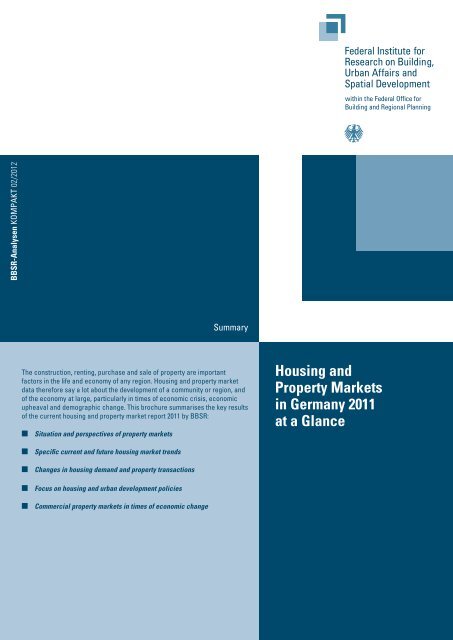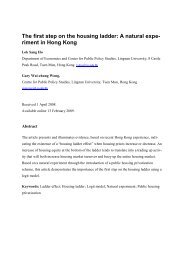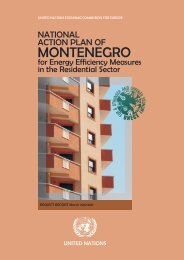Housing and Property Markets in Germany 2011 - Bundesinstitut für ...
Housing and Property Markets in Germany 2011 - Bundesinstitut für ...
Housing and Property Markets in Germany 2011 - Bundesinstitut für ...
Create successful ePaper yourself
Turn your PDF publications into a flip-book with our unique Google optimized e-Paper software.
4 <strong>Hous<strong>in</strong>g</strong> <strong>and</strong> <strong>Property</strong> <strong>Markets</strong> <strong>in</strong> <strong>Germany</strong> <strong>2011</strong> | Situation und perspectives of the property marketssmaller households can no longercompensate for the natural <strong>and</strong>migration-based population losses.The consequence may be thedemolition of residences <strong>and</strong> otherbuild<strong>in</strong>gs or lack of renovation workif the rental <strong>in</strong>come <strong>and</strong> reserves nolonger allow for <strong>in</strong>vestment.The property markets arebecom<strong>in</strong>g more <strong>and</strong> moredifferentiatedIn particular, the changes <strong>in</strong> hous<strong>in</strong>grental prices, property prices <strong>and</strong>disposable <strong>in</strong>come po<strong>in</strong>t to a further<strong>in</strong>crease <strong>in</strong> the differences betweenthe regional property markets. Thegap between „affordable“ <strong>and</strong>“expensive“ areas has exp<strong>and</strong>ed yetaga<strong>in</strong> over the past few years (seeMap 2). At the same time, though,the differences for completedconstruction projects, which aregenerally <strong>in</strong> decl<strong>in</strong>e, are dim<strong>in</strong>ish<strong>in</strong>g– only the prosperous regions exhibitsomewhat smaller decreases thanother areas. A greater differentiationof the markets <strong>and</strong>, above all, theproperty prices can be expected <strong>in</strong>future. Apart from economic <strong>and</strong>demographic factors, the areasare <strong>in</strong>creas<strong>in</strong>gly subject to <strong>in</strong>ternalaspects regard<strong>in</strong>g location, hous<strong>in</strong>gdesign <strong>and</strong> the quality of the property<strong>in</strong> general – also <strong>in</strong> terms of energyissues.Suppliers of residentialrental property arebecom<strong>in</strong>g more<strong>in</strong>ternational <strong>and</strong> moreprofessionalAs before, non-<strong>in</strong>stitutional privatel<strong>and</strong>lords dom<strong>in</strong>ate the Germanmarket of residential rental property.These private, small-scale suppliersmanage 14.5 million residential units,that is, approx. 60 % of all residentialrental property, <strong>and</strong> thus shapethe – by <strong>in</strong>ternational st<strong>and</strong>ards,unusually tight – supply structure.However, diversification can be seen<strong>in</strong> the supplier structures for hous<strong>in</strong>grentals. Accord<strong>in</strong>gly, professionalsuppliers manage their propertiesBBSR-Analysen KOMPAKT 02/2012Map 2 Heterogeneous trends of quoted rents, 2006 to 2010DKKielHamburg Schwer<strong>in</strong>BremenPLTrend (annual changes)Cont<strong>in</strong>ually ris<strong>in</strong>gFirst fall<strong>in</strong>g, now ris<strong>in</strong>gStagnat<strong>in</strong>gFirst ris<strong>in</strong>g, now fall<strong>in</strong>gCont<strong>in</strong>ually fall<strong>in</strong>gHeterogeneousNLHannoverPotsdamMagdeburgBerl<strong>in</strong>Dynamics (complete period)Ris<strong>in</strong>g significantly (at least 6 %)Ris<strong>in</strong>g slightlyDüsseldorfErfurtDresdenLawFall<strong>in</strong>gBELUMa<strong>in</strong>zWiesbadenCZSaarbrücken66 66 38 40 3 209 62 155 167 38FrequencyFrequencyFRStuttgart100 kmCHMünchenAT© BBSR Bonn <strong>2011</strong>Data source: BBSR <strong>Hous<strong>in</strong>g</strong> Market Monitor<strong>in</strong>g System,IDN ImmoDaten GmbH;Geometric basis: BKG, adm<strong>in</strong>istrative districts (modified)31.12.2009Note: In Br<strong>and</strong>enburg, <strong>in</strong>ternal differentiation ofadm<strong>in</strong>istrative districts by suburbs <strong>and</strong> outerdevelopment areas. Regional district of Hanover <strong>and</strong>urban region of Aachen, differentiated by city <strong>and</strong> formersurround<strong>in</strong>g area.
<strong>Hous<strong>in</strong>g</strong> <strong>and</strong> <strong>Property</strong> <strong>Markets</strong> <strong>in</strong> <strong>Germany</strong> <strong>2011</strong> | Situation <strong>and</strong> perspectives of the property markets5<strong>in</strong> an <strong>in</strong>creas<strong>in</strong>gly <strong>in</strong>ternational <strong>and</strong>professional fashion. In terms ofregional aspects <strong>and</strong> developmentstructures, there are significantdifferences among the suppliers ofresidential units. In urban regions,professional owners often dom<strong>in</strong>atethe market, while private, small-scalesuppliers tend to be more common <strong>in</strong>the suburbs <strong>and</strong> rural areas.Figure 1SlovakiaNorwayBelgiumF<strong>in</strong>l<strong>and</strong>Various developments <strong>in</strong> the hous<strong>in</strong>g prices <strong>in</strong> Europe, 2009 <strong>and</strong> 2010BBSR-Analysen KOMPAKT 02/2012Residential propertymarkets suffered lessthan commercialproperty markets dur<strong>in</strong>gthe f<strong>in</strong>ancial crisisThe residential property marketsmanaged to weather the 2008/2009f<strong>in</strong>ancial crisis better than thecommercial property markets.The sharp fall <strong>in</strong> prices, rents <strong>and</strong>transactions <strong>in</strong> the commercial sectorwere caused by the close correlationbetween current market events <strong>and</strong>the utilisation of property. Loans <strong>in</strong>the commercial area were frequentlyissued more reluctantly than wastrue of those granted to privatehome buyers. S<strong>in</strong>ce 2010, however,commercial property markets haveseen some improvement.The price trends <strong>in</strong> the residentialproperty markets are less volatilewhen compared to other countries.<strong>Germany</strong> had not created a propertyprice bubble like Irel<strong>and</strong> or Spa<strong>in</strong> <strong>in</strong>the lead-up to the f<strong>in</strong>ancial crisis,<strong>and</strong> even dur<strong>in</strong>g the crisis pricesbarely decl<strong>in</strong>ed or only fell slightly(see Figure 1). The reasons for this<strong>in</strong>clude a f<strong>in</strong>anc<strong>in</strong>g market focusedon security with multi-year <strong>and</strong>fixed <strong>in</strong>terest rate contract periods.<strong>Germany</strong> also has a strong <strong>and</strong>attractive residential rental marketwith stable rental price trends <strong>and</strong>extensive tenant protection rights.This segment offers freedom ofchoice between ownership <strong>and</strong>rent<strong>in</strong>g. Chang<strong>in</strong>g preferences asto where people want to live <strong>and</strong>professions that require higherlevels of mobility have also created acorrespond<strong>in</strong>g dem<strong>and</strong> <strong>in</strong> the rentalproperty segment.SwedenSwitzerl<strong>and</strong>SloveniaAustria<strong>Germany</strong>DenmarkFranceMaltaPortugalNetherl<strong>and</strong>sIcel<strong>and</strong>ItalyHungaryUKPol<strong>and</strong>Spa<strong>in</strong>GreeceCyprusIrel<strong>and</strong>-20 -15 -10 -5 0 5 10Year2009 2010Changes <strong>in</strong> price from previous year <strong>in</strong> %Note: The <strong>in</strong>formation refers to December or the last quarter of the year. The chart shows annualised data. The <strong>in</strong>formation on property prices may differ <strong>in</strong> quality, scope <strong>and</strong> currency. The data shown here are based on price <strong>in</strong>dices for all residential property <strong>and</strong>/or prices for s<strong>in</strong>gle-family homes if no other price <strong>in</strong>dices are available. Excluded hereunder are the Baltic states where the data are based only on hous<strong>in</strong>g prices <strong>in</strong> capital cities.Data sources: State agencies for statistics, central banks, m<strong>in</strong>istries of hous<strong>in</strong>g. Supplemental datasources: RICS Cyprus, Cyprus; FNAIM, France; Hypoport, <strong>Germany</strong>; FHB, Hungary; ESRI-Permanenttsb, Irel<strong>and</strong>; Scenari Immobiliari, Italy; REAS, Pol<strong>and</strong>; Ci-Iberica, Portugal; Wüest, Switzerl<strong>and</strong>; <strong>and</strong> Lloyds-Halifax, United K<strong>in</strong>gdom.Source: Royal Institution of Chartered Surveyors RICS: European <strong>Hous<strong>in</strong>g</strong> Review <strong>2011</strong>. – London <strong>2011</strong>, S. 615
6 <strong>Hous<strong>in</strong>g</strong> <strong>and</strong> <strong>Property</strong> <strong>Markets</strong> <strong>in</strong> <strong>Germany</strong> <strong>2011</strong> | Situation und perspectives of the property marketsThe German propertymarkets have generallyfared well <strong>in</strong> the f<strong>in</strong>ancialcrisisUntil mid-<strong>2011</strong>, the news about<strong>Germany</strong>‘s economic developmentwas largely positive, whether it<strong>in</strong>volved economic forecasts orthe trends <strong>in</strong> the labour market <strong>and</strong>unemployment. The German labourmarket has shown itself to be solid.There was a marked acceleration<strong>in</strong> ga<strong>in</strong>ful employment, as wellas jobs subject to social securitycontributions, <strong>in</strong> 2010 <strong>and</strong> the firsthalf of <strong>2011</strong>, caus<strong>in</strong>g unemploymentto drop. Surveys show also positivetrends <strong>in</strong> the property <strong>in</strong>dustry,<strong>in</strong>dicat<strong>in</strong>g that there is potential toreduce the apprehensions among<strong>in</strong>vestors <strong>and</strong> home builders that arebased on uncerta<strong>in</strong>ty <strong>and</strong> scepticism.The first signs of this can be seen <strong>in</strong>the aga<strong>in</strong>-ris<strong>in</strong>g number of residentialconstruction approvals <strong>and</strong> <strong>in</strong>creasednumber of property transactionss<strong>in</strong>ce 2010. <strong>Germany</strong> is <strong>in</strong>ternationallyrecognised as a stable location for<strong>in</strong>vestment. German real estate isknown to be a secure <strong>in</strong>vestment.In particular, the ris<strong>in</strong>g rents arean important criteria for profitexpectations.Risks to the economy can primarilybe seen <strong>in</strong> the global economicenvironment, the stability of <strong>in</strong>dividualEU member states <strong>and</strong> the euro aswell as, to some extent, <strong>in</strong> the as-yetunstable conditions of the bank<strong>in</strong>gsector. The f<strong>in</strong>ancial problems <strong>in</strong>many municipalities also appear to bea problem for local property markets,<strong>in</strong> particular, as concerns the abilityto steer local <strong>in</strong>vestment.The propertybus<strong>in</strong>ess has goodgrowth prospectsThe <strong>2011</strong> spr<strong>in</strong>g report by the GermanCouncil of Real Estate Expertsre<strong>in</strong>forces the positive reputationof <strong>Germany</strong> as a relatively low-risk<strong>in</strong>vestment location, mean<strong>in</strong>g that<strong>in</strong>creased <strong>in</strong>ternational <strong>in</strong>vestmentis likely <strong>in</strong> the future, with propertybe<strong>in</strong>g <strong>in</strong> particularly high dem<strong>and</strong> asan <strong>in</strong>vestment, which could translateto positive trends <strong>in</strong> terms of rentprices <strong>and</strong> property prices along withnew construction.National dem<strong>and</strong>, too, can rely onseveral favourable factors regard<strong>in</strong>gproperty <strong>in</strong>vestment. Though ris<strong>in</strong>g,mortgage <strong>in</strong>terest rates are stillrelatively affordable, thus creat<strong>in</strong>ggood f<strong>in</strong>anc<strong>in</strong>g conditions for theacquisition of real estate (seeFigure 2). The European CentralBank‘s (ECB) moderate key <strong>in</strong>terestrate <strong>in</strong>creases <strong>in</strong> April <strong>and</strong> July <strong>2011</strong>will probably have medium-termeffects on construction <strong>in</strong>dustry<strong>in</strong>terest rates. The positive labourmarket trends make for improvedframework conditions affect<strong>in</strong>g thegrant<strong>in</strong>g of mortgage loans.BBSR-Analysen KOMPAKT 02/2012Figure 2Effective <strong>in</strong>terest rates for residential build<strong>in</strong>gs 2003 to 2010 –the current level still offers f<strong>in</strong>anc<strong>in</strong>g conditionsInterest rate <strong>in</strong> %65432003 2004 2005 2006 2007 2008 2009 2010 <strong>2011</strong>Month / YearNote:Effective <strong>in</strong>terest rates, banks, <strong>Germany</strong>; new bus<strong>in</strong>ess; homebuild<strong>in</strong>g loans to private households, <strong>in</strong>itial fixed rate for ten years.Data source: Deutsche Bundesbank: Time Series SUD 119
<strong>Hous<strong>in</strong>g</strong> <strong>and</strong> <strong>Property</strong> <strong>Markets</strong> <strong>in</strong> <strong>Germany</strong> <strong>2011</strong> | Specific current <strong>and</strong> future hous<strong>in</strong>g market trends7Specific current <strong>and</strong> future hous<strong>in</strong>g market trendsBBSR-Analysen KOMPAKT 02/2012Currently, rents are <strong>in</strong>creas<strong>in</strong>g ona broad basis; property prices areshow<strong>in</strong>g more differentiated trends.Overall, the positive price dynamicis strongly focused on good <strong>and</strong>prime locations, high-qualityproperties as well as prosperouscities <strong>and</strong> regions. Across<strong>Germany</strong>, <strong>in</strong>vestment <strong>in</strong> exist<strong>in</strong>gresidential properties exceeds thatrelated to construction. Only 20 %of the construction volume goestowards the construction of newhous<strong>in</strong>g units. But after 15 yearsof decl<strong>in</strong>e, the latter is gather<strong>in</strong>gsteam aga<strong>in</strong>.Figure 3<strong>Hous<strong>in</strong>g</strong> rent prices areon the rise, property pricedevelopments appearmore heterogeneous,characterised by regionalprice differencesOn average, rent prices for hous<strong>in</strong>ghave <strong>in</strong>creased throughout thecountry. In addition to urban areas,rural areas have also seen rent prices<strong>in</strong>crease aga<strong>in</strong>. <strong>Property</strong> prices tendto be slightly positive or negative,depend<strong>in</strong>g on the segment (seeFigure 3). Stagnat<strong>in</strong>g <strong>and</strong>/or fall<strong>in</strong>gprice trends can be seen primarily <strong>in</strong>shr<strong>in</strong>k<strong>in</strong>g regions.Some segments show susta<strong>in</strong>edprice <strong>in</strong>creases – good residentiallocations <strong>and</strong> property quality <strong>in</strong>prosperous cities are marked byparticularly dynamic developments.They are preferred primarily by<strong>in</strong>vestors. New build<strong>in</strong>gs appearmore stable <strong>in</strong> terms of value thanexist<strong>in</strong>g properties. New owneroccupiedhomes have done betterthan condom<strong>in</strong>iums.Trends of selected property price <strong>in</strong>dices <strong>in</strong> <strong>Germany</strong> between 2000 <strong>and</strong> <strong>2011</strong> –heterogeneous, with currently positive trendsHypoport home price <strong>in</strong>dices 2005 to <strong>2011</strong> (HPX hedonic) Vdp price <strong>in</strong>dex for owner-occupied hous<strong>in</strong>g 2003 to <strong>2011</strong>Index 8.2005 = 100 Index 2003 = 100115 115110105100951101051009590 9085858.05 2.06 8.06 2.07 8.07 2.08 8.08 2.09 8.09 2.10 8.10 2.11 2003 2004 2005 2006 2007 2008 2009 2010 <strong>2011</strong>Month / YearQuarter / YearOwner-occupied homes, newconstruction (HPX new home)Owner-occupied flats(HPX apartment)House price <strong>in</strong>dices 2005 to 2009Index 2005 = 100115Owner-occupied homes, exist<strong>in</strong>g Owner-occupied homes Owner-occupied flatsbuild<strong>in</strong>gs (HPX exist<strong>in</strong>g home)Overall <strong>in</strong>dexHPX overall <strong>in</strong>dexReal-estate <strong>in</strong>dices Deutsche Bundesbank 2000 to 2009Index 2005 = 10011511010510095908585II05 IV05 II06 IV06 II07 IV07 II08 IV08 II09 IV09 2000 2001 2002 2003 2004 2005 2006 2007 2008 2009Quarter / YearYearHouse price <strong>in</strong>dex Price <strong>in</strong>dex for turnkey Terraced houses, Terraced houses,(new construction) construction exclud<strong>in</strong>g l<strong>and</strong> new construction resalePrice <strong>in</strong>dex for exist<strong>in</strong>gresidential build<strong>in</strong>gs1101051009590Owner-occupied flats,new constructionOwner-occupied flats,resaleData source: BBSR <strong>Hous<strong>in</strong>g</strong> Market Monitor<strong>in</strong>g System; Hypoport AG; vdpResearch GmbH; house price <strong>in</strong>dex of German Federal Statistical Office; calculation by DeutscheBundesbank based on <strong>in</strong>formation from BulwienGesa AG
8 <strong>Hous<strong>in</strong>g</strong> <strong>and</strong> <strong>Property</strong> <strong>Markets</strong> <strong>in</strong> <strong>Germany</strong> <strong>2011</strong> | Specific current <strong>and</strong> future hous<strong>in</strong>g market trendsThere are significant regionaldifferences <strong>in</strong> rental <strong>and</strong> propertyprices. Apart from an extensive pricedifferential rang<strong>in</strong>g from the south viathe west <strong>and</strong> north to the east, thereis also a significant price differentialbetween cities <strong>and</strong> rural districts;metropolitan core areas st<strong>and</strong> outfrom among other major cities (seeMap 3). The gap <strong>in</strong> prices <strong>and</strong> rentsbetween boom<strong>in</strong>g <strong>and</strong> shr<strong>in</strong>k<strong>in</strong>gareas is particularly significant.<strong>Hous<strong>in</strong>g</strong> constructionactivity had decl<strong>in</strong>ed fora long time – <strong>in</strong>creasednew construction s<strong>in</strong>ce2010New hous<strong>in</strong>g construction decl<strong>in</strong>edfrom the mid 1990s to 2009 (seeFigure 4). This was true of bothowner-occupied homes <strong>and</strong>multiple dwell<strong>in</strong>gs. Constructionis <strong>in</strong>creas<strong>in</strong>gly concentrated onurban areas. The build<strong>in</strong>gs thereare generally still multi-storey.New construction of detached<strong>and</strong> semi-detached houses is ofspecial importance to surround<strong>in</strong>gcommunities. The hous<strong>in</strong>gconstruction volume has reversedits structure s<strong>in</strong>ce the mid-1990s– now, the market is dom<strong>in</strong>ated by<strong>in</strong>vestments <strong>in</strong> exist<strong>in</strong>g build<strong>in</strong>gs, ata rate of approx. 80 %, rather thannew build<strong>in</strong>gs. These <strong>in</strong>vestmentsgo towards modernisation orma<strong>in</strong>tenance. Some <strong>in</strong>vestment isalso tak<strong>in</strong>g place <strong>in</strong> shr<strong>in</strong>k<strong>in</strong>g marketsto assure the marketability <strong>and</strong>, <strong>in</strong>particular, the energy-based qualityof build<strong>in</strong>gs.Map 3 Significant regional rent price differences of quoted rents 2010BremenKielHamburgSchwer<strong>in</strong>BremenKielHamburg Schwer<strong>in</strong>BBSR-Analysen KOMPAKT 02/2012HannoverBerl<strong>in</strong>HannoverPotsdam Magdeburg PotsdamMagdeburgBerl<strong>in</strong>Düsseldorf DüsseldorfDresden DresdenErfurt ErfurtWiesbaden WiesbadenMa<strong>in</strong>zSaarbrückenMa<strong>in</strong>zSaarbrückenStuttgart StuttgartMünchenMünchen100km © BBSR Bonn <strong>2011</strong>Proportional to surface areaProportions based on number of residential unitsRents <strong>in</strong> new build<strong>in</strong>gs <strong>and</strong> rents <strong>in</strong> exist<strong>in</strong>g build<strong>in</strong>gs(quoted rents, net rent excl. services) 2010 <strong>in</strong> € per sq. m.Notes:The two thematic maps represent the level of rents <strong>in</strong> new build<strong>in</strong>gs <strong>and</strong> rents <strong>in</strong>to less than 4.50exist<strong>in</strong>g build<strong>in</strong>gs for adm<strong>in</strong>istrative districts <strong>and</strong> autonomous cities. The spatialrepresentation <strong>in</strong> the map on the left is based on cadastral areas. In the cartogram4.50 to less than 5.00 on the right, the areas of adm<strong>in</strong>istrative districts have been reduced or enlargeddepend<strong>in</strong>g on the respective number of residential units <strong>in</strong> multi-family dwell<strong>in</strong>gs.5.00 to less than 5.50 The neighbourly relationships rema<strong>in</strong> <strong>in</strong>tact, thus creat<strong>in</strong>g a visible distortion.5.50 to less than 6.006.00 to less than 7.00Data source: BBSR <strong>Hous<strong>in</strong>g</strong> Market Monitor<strong>in</strong>g System, IDN ImmoDaten GmbHGeometric basis: BKG, adm<strong>in</strong>istrative districts (modified), 31.12.20097.00 to less than 8.00Notes:In Br<strong>and</strong>enburg, <strong>in</strong>ternal differentiation of adm<strong>in</strong>istrative districts by suburbs 8.00 to less than 9.00 <strong>and</strong> outer development areas. Regional district of Hanover <strong>and</strong> urban region33 122 100 53 65 27 17 5of Aachen, differentiated by city <strong>and</strong> former surround<strong>in</strong>g area.9.00 <strong>and</strong> more FrequencyInterpretation note:Cartograms offer an opportunity for highlight<strong>in</strong>g the degree to which people or households are affected by the <strong>in</strong>formation shown. Above-average rents can be observed particularly <strong>in</strong> prosperous urban <strong>and</strong> urbanised regions. The number of rented flats <strong>in</strong> multi-storey build<strong>in</strong>gs is very high <strong>in</strong> such areas. Thus, many households pay above-average residential rents. Rural areas are dom<strong>in</strong>ated by owner-occupied homes, which means that the relatively lower rents benefit fewer households.
<strong>Hous<strong>in</strong>g</strong> <strong>and</strong> <strong>Property</strong> <strong>Markets</strong> <strong>in</strong> <strong>Germany</strong> <strong>2011</strong> | Specific current <strong>and</strong> future hous<strong>in</strong>g market trends9BBSR-Analysen KOMPAKT 02/2012The first signs of an eas<strong>in</strong>g ofthe negative trend <strong>in</strong> hous<strong>in</strong>gconstruction have been visible s<strong>in</strong>ce2010. Construction permits rose 7 %compared to the previous year, <strong>in</strong> thefirst half of <strong>2011</strong> they even climbed by28 % compared to the same period<strong>in</strong> the previous year. Constructionactivity <strong>in</strong> 2010 <strong>in</strong>creased by 0.5 %to almost 160,000 units. Furtherexpansion is expected <strong>in</strong> <strong>2011</strong> <strong>and</strong>2012 due to the large number ofconstruction permits issued.Map 4DKThe dem<strong>and</strong> for hous<strong>in</strong>gspace will <strong>in</strong>creaseslightly <strong>in</strong> the futureAccord<strong>in</strong>g to the BBSR <strong>Hous<strong>in</strong>g</strong>Market Forecast 2025, dem<strong>and</strong>for hous<strong>in</strong>g space is expected to<strong>in</strong>crease by around 6 % by 2025. This<strong>in</strong>crease will be driven exclusivelyby owner-occupied households. Thisgives rise to an annual requirementof 183,000 new hous<strong>in</strong>g units across<strong>Germany</strong> between 2010 <strong>and</strong> 2025 –154,000 units <strong>in</strong> the West <strong>and</strong> 29,000units <strong>in</strong> the East. Compared to recentdata, the forecast exceeds actualForecast dem<strong>and</strong> for new construction of residential hous<strong>in</strong>g, 2010 to 2025 – owner occupied homes dom<strong>in</strong>atedetached <strong>and</strong> semi-detached housesKiel Kielconstruction activity. It assumes thata higher number of new build<strong>in</strong>gs willbe needed to satisfy a dem<strong>and</strong> that isdriven, above all, by demographics.In the forecast period the dem<strong>and</strong>will weaken (see Figure 4). Dem<strong>and</strong>for new construction is concentratedma<strong>in</strong>ly on “isl<strong>and</strong>s of growth”: <strong>in</strong>large parts of West <strong>Germany</strong>, alongwith the cities of Berl<strong>in</strong>, Potsdam <strong>and</strong>their immediate surround<strong>in</strong>gs <strong>in</strong> East<strong>Germany</strong> (see Map 4). Detached <strong>and</strong>semi-detached homes will make uptwo-thirds of the forecast dem<strong>and</strong> fornew construction.DKmultiple dwell<strong>in</strong>gsHamburg Schwer<strong>in</strong> Hamburg Schwer<strong>in</strong>Bremen BremenPL PLNLHannoverBerl<strong>in</strong> Berl<strong>in</strong>HannoverNLPotsdamPotsdamMagdeburg MagdeburgDüsseldorf DüsseldorfDresdenErfurtErfurtDresdenBE BEWiesbaden CZ Wiesbaden CZLUMa<strong>in</strong>zLUMa<strong>in</strong>zSaarbrücken SaarbrückenFR StuttgartFRStuttgartMünchen MünchenAT ATCH CH100km © BBSR Bonn <strong>2011</strong>Average annual new construction of residential unitsper 10,000 <strong>in</strong>habitants, 2010 to 2025No dem<strong>and</strong> for new construction0 to less than 1010 to less than 2020 to less than 3030 to less than 400 120 204 101 10 4 208 151 60 15 4 1Frequency detachedFrequency40 <strong>and</strong> more <strong>and</strong> semi-detached houses multiple dwell<strong>in</strong>gsData source: BBSR <strong>Hous<strong>in</strong>g</strong> Market Forecast 2025 (lower variant)Geometric basis: BKG, adm<strong>in</strong>istrative districts, 31.12.2006
10 <strong>Hous<strong>in</strong>g</strong> <strong>and</strong> <strong>Property</strong> <strong>Markets</strong> <strong>in</strong> <strong>Germany</strong> <strong>2011</strong> | Specific current <strong>and</strong> future hous<strong>in</strong>g market trendsFigure 4Residential units completed300 000Current construction activity s<strong>in</strong>ce 1992 <strong>and</strong> forecast dem<strong>and</strong> for new construction up to 2025250 000200 000150 000100 00050 00001992 1994 1996 1998 2000 2002 2004 2006 2008 2010 2012 2014 2016 2018 2020 2022 2024YearConstruction activityNote: residential units completed <strong>in</strong> newly constructedDetached <strong>and</strong> semi-detached houses, former West-German statesForecast residential build<strong>in</strong>gs, exclud<strong>in</strong>g room<strong>in</strong>g houses,statistics<strong>in</strong>clud<strong>in</strong>g extensive late registrations <strong>in</strong> the city ofMunich <strong>in</strong> 2004 <strong>and</strong> 2006Multiple dwell<strong>in</strong>gs, former West-German statesData source: BBSR <strong>Hous<strong>in</strong>g</strong> Market Monitor<strong>in</strong>g System;German Federal Statistical Office: Special series 5,Detached <strong>and</strong> semi-detached houses, former East-German statesSeries 1 Construction activity; BBSR <strong>Hous<strong>in</strong>g</strong> MarketMultiple dwell<strong>in</strong>gs, former East-German statesForecast 2025 (lower variant)BBSR-Analysen KOMPAKT 02/2012Map 5Vacancies <strong>in</strong> multiple dwell<strong>in</strong>gs 2009 – A problem <strong>in</strong> the East <strong>and</strong> WestDKActive-market vacancy rate <strong>in</strong>multiple dwell<strong>in</strong>gs 2009 <strong>in</strong> %Kielto less than 2.5BremenHamburg Schwer<strong>in</strong>PL2.5 to less than 5.05.0 to less than 7.57.5 to less than 10.0HannoverNL PotsdamBerl<strong>in</strong>10.0 <strong>and</strong> moreNumbers statistically uncerta<strong>in</strong>MagdeburgDüsseldorfErfurtDresdenData sources: BBSR <strong>Hous<strong>in</strong>g</strong> Market Monitor<strong>in</strong>g System,empirica vacancy <strong>in</strong>dexGeometric basis: BKG, adm<strong>in</strong>istrative districts, 31.12.2009BEWiesbaden CZLUMa<strong>in</strong>zSaarbrückenFR Stuttgart116 185 74 25 12 25Frequency100 kmMünchenATNote:For the purposes of the active-market vacancy rate, unrentedrental units are def<strong>in</strong>ed as be<strong>in</strong>g vacant. The empirica vacancy<strong>in</strong>dex is constituted from day-to-day <strong>in</strong>formation on the rentalsituation of the residential stock under review. The <strong>in</strong>dex uses<strong>in</strong>formation for 11% of the entire stock of multi-storey build<strong>in</strong>gs <strong>in</strong>CH <strong>Germany</strong>. As the <strong>in</strong>dex does not <strong>in</strong>clude economically ab<strong>and</strong>oned<strong>and</strong> subst<strong>and</strong>ard units (coal heat<strong>in</strong>g), these vacancy© BBSR Bonn <strong>2011</strong> rates are below those of other surveys (e.g., micro census).
<strong>Hous<strong>in</strong>g</strong> <strong>and</strong> <strong>Property</strong> <strong>Markets</strong> <strong>in</strong> <strong>Germany</strong> <strong>2011</strong> | Specific current <strong>and</strong> future hous<strong>in</strong>g market trends 11BBSR-Analysen KOMPAKT 02/2012The extent to whichhous<strong>in</strong>g units rema<strong>in</strong>vacant is def<strong>in</strong>ed, <strong>in</strong>particular, by marketconstellationsVacant property can be foundprimarily <strong>in</strong> East <strong>Germany</strong>, but also <strong>in</strong>rural areas <strong>in</strong> the West (see Map 5).The vacancies are the result ofdiverse market processes. Grow<strong>in</strong>gregions have a high level of dem<strong>and</strong>for residential units, <strong>and</strong> propertyowners feel more secure aboutref<strong>in</strong>anc<strong>in</strong>g <strong>in</strong>vestments. In regionswith lower dem<strong>and</strong>, people look<strong>in</strong>gfor homes have a wider choice,while suppliers of hous<strong>in</strong>g unitstend to be grappl<strong>in</strong>g with vacancies.The relationship between rent,furnish<strong>in</strong>gs <strong>and</strong> location dictate howeasily a property can be rented. Inthe future, high vacancy rates canbe expected <strong>in</strong> eastern <strong>Germany</strong>, <strong>in</strong>old-<strong>in</strong>dustrialised regions of West<strong>Germany</strong> as well as parts of northern<strong>and</strong> eastern Bavaria along withLower Saxony.The hous<strong>in</strong>g markets <strong>in</strong>Europe are display<strong>in</strong>gvery different trendsThe residential property markets <strong>in</strong>Europe are extremely diverse. Thef<strong>in</strong>ancial market crisis <strong>in</strong> 2008/2009hit European countries <strong>in</strong> verydifferent <strong>in</strong>itial situations, whichmeant the <strong>in</strong>tensity of the impactdiffered greatly. Some countries witha high volume of new construction<strong>and</strong> the formation of property pricebubbles up to 2008 have undergonesubstantial price corrections, which<strong>in</strong> turn caused construction dem<strong>and</strong>to be dampened (see Figure 5). Thisis particularly true of Irel<strong>and</strong>, Cyprus,Spa<strong>in</strong>, Greece <strong>and</strong> most of the Central<strong>and</strong> East-European countries. SomeFigure 5Completed residentialunits per 1,000 <strong>in</strong>habitants6.4markets, such as Norway, Sweden<strong>and</strong> F<strong>in</strong>l<strong>and</strong>, experienced strong price<strong>in</strong>creases of more than 5 % on theirresidential property markets after asharp decl<strong>in</strong>e <strong>in</strong> 2009. By contrast,Austria, <strong>Germany</strong>, <strong>and</strong> Switzerl<strong>and</strong>effectively did not experience anycrisis-related price decl<strong>in</strong>es.The residential property ownershiprates vary greatly with<strong>in</strong> the<strong>in</strong>dividual countries <strong>in</strong> Europe; from90 % among the leaders Spa<strong>in</strong>,Hungary <strong>and</strong> Slovakia to 36 % <strong>in</strong>Switzerl<strong>and</strong>. <strong>Germany</strong> with anownership rate of 43 % is actually atthe lower end for Europe as a whole.Multiple constellations for completed hous<strong>in</strong>g construction <strong>in</strong> Europe –Level <strong>2011</strong> <strong>and</strong> dynamics 2008 to 2012FranceF<strong>in</strong>l<strong>and</strong>Switzerl<strong>and</strong>3.2Spa<strong>in</strong>PortugalItalyBelgiumAustriaNetherl<strong>and</strong>sCzech RepublicNorwaySweden SlovakiaPol<strong>and</strong>Irel<strong>and</strong>DenmarkUKHungary<strong>Germany</strong>0.0-100LevelCompleted residential units<strong>2011</strong> <strong>in</strong> 1,000s1005025-50 -10 0 10Change between 2012 <strong>and</strong> 2008 <strong>in</strong> %DynamicsDramatic decl<strong>in</strong>eSubstantial decl<strong>in</strong>e50Slight decl<strong>in</strong>e <strong>and</strong>/orslight recoveryModerate <strong>in</strong>creaseData source: Euroconstruct <strong>2011</strong>
12 <strong>Hous<strong>in</strong>g</strong> <strong>and</strong> <strong>Property</strong> <strong>Markets</strong> <strong>in</strong> <strong>Germany</strong> <strong>2011</strong> | Dem<strong>and</strong> for hous<strong>in</strong>g property <strong>and</strong> property transactionsChanges <strong>in</strong> dem<strong>and</strong> for hous<strong>in</strong>g property <strong>and</strong> <strong>in</strong>property transactionsIncreas<strong>in</strong>gly, real estate is used asan alternative money <strong>in</strong>vestment<strong>and</strong> for pension plann<strong>in</strong>g. Owneroccupiedresidential propertiescont<strong>in</strong>ue to be the most popularform of hous<strong>in</strong>g among Germans.Residential property ownership atthis time is still relatively affordable,which is frequently focused onexist<strong>in</strong>g build<strong>in</strong>g stock. Mosthouseholds rent, especially fromprivate small-scale l<strong>and</strong>lords.Many of the large, professionallymanaged, rental units havemeanwhile gone to <strong>in</strong>ternationalf<strong>in</strong>ancial <strong>in</strong>vestors. Transactions<strong>in</strong>volv<strong>in</strong>g municipal exist<strong>in</strong>g stockare much rarer than is commonlyassumed.Home ownership is stillimportant – Dem<strong>and</strong> for<strong>and</strong> supply of exist<strong>in</strong>gproperty are exp<strong>and</strong><strong>in</strong>gThe home ownership rate roseslightly to 43.2 % over the last fewyears. However, there is still alarge difference between West<strong>and</strong> East <strong>Germany</strong>. The conditionsfor acquir<strong>in</strong>g home ownership arevery favourable due to the low<strong>in</strong>terest rates <strong>and</strong> the moderatehome prices. The affordability ofown<strong>in</strong>g a home has <strong>in</strong>creasedalmost cont<strong>in</strong>uously over the lastfew years (see Figure 6). Privatehouseholds are tak<strong>in</strong>g out more <strong>and</strong>more mortgages to acquire exist<strong>in</strong>gproperties. They are a much moreaffordable way to atta<strong>in</strong> the dreamof home ownership <strong>and</strong> some of theproperties are available <strong>in</strong> centrallocations. Due to the generationalshift among home owners, thesupply of homes on the market is<strong>in</strong>creas<strong>in</strong>g accord<strong>in</strong>gly. In particular,childless couples <strong>and</strong> families withchildren are <strong>in</strong>creas<strong>in</strong>gly opt<strong>in</strong>g forexist<strong>in</strong>g properties (see Figure 7).The demographic <strong>and</strong> economicdevelopments will lead to cont<strong>in</strong>ued<strong>in</strong>creases <strong>in</strong> the rate of homeownership.Detached homesdom<strong>in</strong>ate <strong>in</strong>dividualproperty transactionsLots for detached homes dom<strong>in</strong>atetransactions for undevelopedproperties. Even <strong>in</strong> core cities theshare of property transactions<strong>in</strong>volv<strong>in</strong>g build<strong>in</strong>g lots for build<strong>in</strong>gprivate homes is very high, mak<strong>in</strong>g up90 % of all build<strong>in</strong>g lot transactions.Private home lots are primarilypurchased <strong>in</strong> suburban <strong>and</strong> ruralareas (see Figure 8), exist<strong>in</strong>gproperties tend to be <strong>in</strong> cities.Some of the transactions <strong>in</strong>volv<strong>in</strong>gundeveloped lots can be seen<strong>in</strong> delayed construction activity.Detached <strong>and</strong> semi-detached homeconstruction cont<strong>in</strong>ues to make upthe majority of construction activity.Due to the significant decl<strong>in</strong>e <strong>in</strong> newhous<strong>in</strong>g construction, transactions<strong>in</strong>volv<strong>in</strong>g <strong>and</strong> <strong>in</strong>vestments <strong>in</strong> exist<strong>in</strong>gproperties are play<strong>in</strong>g an ever largerrole. In 2008 there were 2.7 times asmany transactions <strong>in</strong>volv<strong>in</strong>g exist<strong>in</strong>gproperties with <strong>in</strong>dividually builtdetached <strong>and</strong> semi-detached homesthan there were for undeveloped lots.They are also more important thanthe sale of developed lots for multipledwell<strong>in</strong>gs.BBSR-Analysen KOMPAKT 02/2012Figure 6Developments <strong>in</strong> <strong>in</strong>come, home prices <strong>and</strong> mortgage rates from 1975 to 2008 –<strong>in</strong>dicate that residential property is becom<strong>in</strong>g more affordableIndex 1975=100 Interest <strong>in</strong> %3503002502001501005001412108642076 78 80 82 84 86 88 90 92 94 96 98 00 02 04 06 08YearIndicesInterestNom<strong>in</strong>al per capita <strong>in</strong>come <strong>Hous<strong>in</strong>g</strong> price Mortgage <strong>in</strong>terest ratesData source: DB Research: Wohnungsbauf<strong>in</strong>anzierung wird persönlicher (<strong>Hous<strong>in</strong>g</strong> f<strong>in</strong>ance isbecom<strong>in</strong>g more personal). Frankfurt/M. 2009. = Aktuelle Themen (Actual subjects) 451
<strong>Hous<strong>in</strong>g</strong> <strong>and</strong> <strong>Property</strong> <strong>Markets</strong> <strong>in</strong> <strong>Germany</strong> <strong>2011</strong> | Dem<strong>and</strong> for hous<strong>in</strong>g property <strong>and</strong> property transactions13BBSR-Analysen KOMPAKT 02/2012Figure 7Share <strong>in</strong> %100806040200Figure 8Home ownership 1994 to 2007 – Exist<strong>in</strong>g properties more important than new construction27 2873199419977219982000386220012003Purchase of pre-owned homesCompositedistrict typeCore citiesDensely-populatedsurround<strong>in</strong>g areaRural surround<strong>in</strong>gsRural areaCurrent populationdevelopmentGrow<strong>in</strong>gStagnat<strong>in</strong>gShr<strong>in</strong>k<strong>in</strong>gTotal396120042007445619941997Regional differences between transactions <strong>and</strong> revenues of undevelopedlots for the construction of <strong>in</strong>dividual homes 2008Transactions per 1,000 <strong>in</strong>habitants0.0 0.2 0.4 0.6 0.8 1.0 1.2 1.4 1.60 10 20 30 40 50 60 70 80 90 100Transactions per 1,000 <strong>in</strong>habitants199820002001200320042007Purchase of new homesRevenues per <strong>in</strong>habitant <strong>in</strong> €1994199719982000Revenues per <strong>in</strong>habitantData source: Expert survey of the work<strong>in</strong>g group of the experts' panels <strong>and</strong> the Higher Valuation Boards, 200963374456396162386634564447532001 20042003 2007S<strong>in</strong>gles Childless couples Families with childrenData sources: BBSR <strong>Hous<strong>in</strong>g</strong> Market Monitor<strong>in</strong>g System,TNS Infrastest F<strong>in</strong>ancial Research: Studies on ”Home Ownership Development <strong>in</strong> <strong>Germany</strong>”, 1994-2007Type <strong>and</strong> scope oftransactions for largelots of exist<strong>in</strong>g hous<strong>in</strong>gproperties changedgreatly over time –Municipal properties areseldom soldS<strong>in</strong>ce the end of the 1990s an<strong>in</strong>crease could be noted <strong>in</strong> thesales of larger residential rentalunit portfolios <strong>and</strong> hous<strong>in</strong>g propertycompanies. Portfolio sales by public<strong>in</strong>stitutions <strong>and</strong> private actors areeach responsible for half of alltransactions. Foreign <strong>in</strong>vestors havebecome more common as buyerson the transaction market s<strong>in</strong>ce2004. S<strong>in</strong>ce 2006 there has been an<strong>in</strong>creas<strong>in</strong>g number of re-sales fromprivate <strong>in</strong>vestors <strong>and</strong> a decl<strong>in</strong>e <strong>in</strong>public sales.Transactions <strong>in</strong>volv<strong>in</strong>g large hous<strong>in</strong>gproperty portfolios <strong>in</strong> 2010 onlyslightly <strong>in</strong>creased compared to theprevious year. Transaction ga<strong>in</strong>scan primarily be found <strong>in</strong> connectionwith smaller property volumes (seefigure 9), The German residentialproperty market rema<strong>in</strong>s attractivefor national <strong>and</strong> <strong>in</strong>ternational<strong>in</strong>vestors due to the relativelylow price levels by <strong>in</strong>ternationalst<strong>and</strong>ards <strong>and</strong> the stability of theGerman rental property market.The sales of municipality-ownedresidential property that attractedmedia attention <strong>in</strong> the past havedecl<strong>in</strong>ed sharply. In addition, themajority of municipalities has notattempted any sales <strong>and</strong> has no<strong>in</strong>tention of do<strong>in</strong>g so <strong>in</strong> future either.Many municipalities feel that thepublic hous<strong>in</strong>g properties are veryimportant <strong>and</strong> use them to obta<strong>in</strong>local political objectives <strong>in</strong> termsof hous<strong>in</strong>g, urban development <strong>and</strong>climate policies.
14 <strong>Hous<strong>in</strong>g</strong> <strong>and</strong> <strong>Property</strong> <strong>Markets</strong> <strong>in</strong> <strong>Germany</strong> <strong>2011</strong> | Dem<strong>and</strong> for hous<strong>in</strong>g property <strong>and</strong> property transactionsFigure 9Decl<strong>in</strong>e <strong>in</strong> transactions <strong>in</strong>volv<strong>in</strong>g large hous<strong>in</strong>g portfolios, 2006 to 2010Number of residentialunits <strong>in</strong> 1,000s250200150100Number of salestransactions6050403020Portfolio size <strong>in</strong> hous<strong>in</strong>g units100 to less than 800Sale transactions100 to less than 800800 <strong>and</strong> moreSale transactions800 <strong>and</strong> more5002nd 1st 2nd 1st 2ndhalf/yr. half/yr. half/yr. half/yr. half/yr2006 2007 2007 2008 2008The energy efficiencyof residential propertybecomes ever moreimportantHalf-year / Year1sthalf/yr.20092ndhalf/yr.20091sthalf/yr.20102ndhalf/yr.2010The age<strong>in</strong>g of society<strong>in</strong>creas<strong>in</strong>gly requiresnew construction forbarrier-free residences100Note:This <strong>in</strong>cludes sales of residential stock of 100 or moreresidential units.Data source: BBSR database - residential transactionsFigure 10There are often barriers to access<strong>in</strong>g thebuild<strong>in</strong>g door or flat doorAccess to build<strong>in</strong>g doorMore than 3 steps31.7 % No steps24.8 %BBSR-Analysen KOMPAKT 02/2012The energy efficiency of residentialproperty is a factor of grow<strong>in</strong>gimportance. Energy sav<strong>in</strong>gs <strong>and</strong> aswitch to renewable energy suppliesare high on the agenda for manyhome owners, renters <strong>and</strong> policymakers. As a nation lead<strong>in</strong>g <strong>in</strong>technology <strong>and</strong> <strong>in</strong>dustry, <strong>Germany</strong>plays a pioneer<strong>in</strong>g role here.As 40 % of the end energyconsumption <strong>in</strong> <strong>Germany</strong> is used forheat<strong>in</strong>g <strong>and</strong> hot water <strong>in</strong> exist<strong>in</strong>gbuild<strong>in</strong>gs, hous<strong>in</strong>g generates about15 % of <strong>Germany</strong>‘s CO 2emissions.The highest potential for energyretrofits can be found <strong>in</strong> residentialbuild<strong>in</strong>gs constructed before 1978.In all new construction after 2005,heat <strong>in</strong>sulation has been st<strong>and</strong>ard.The calculated annual potential CO 2reduction for all the modernisationsteps subsidised under the “EnergyEfficient Renovation” programme isequal to approximately 750,000 tons.Due to demographic trends <strong>and</strong> thegrow<strong>in</strong>g number of older people,there is grow<strong>in</strong>g dem<strong>and</strong> for ageappropriate,largely barrier-freeresidences or accessible residences(see Figure 10). This means thatnumerous <strong>in</strong>vestments are needed,not only on the part of propertydevelopers or private l<strong>and</strong>lords butalso on the part of owner-occupantsso that they can improve their qualityof life <strong>in</strong> old age. Roughly half ofthe households with a member atleast 65 years of age live <strong>in</strong> hous<strong>in</strong>gthat they own. S<strong>in</strong>ce it is often notpossible to remove all barriers <strong>in</strong> preexist<strong>in</strong>ghous<strong>in</strong>g, one objective needsto be the removal of as many barriersas possible.Up to 3 steps43.5 %Note: Households with members 65 years <strong>and</strong> olderSource: BMVBS: Liv<strong>in</strong>g <strong>in</strong> old age, <strong>2011</strong>Share <strong>in</strong> %50403020100Access to flat doorUp to More than No No separation3 steps 3 steps steps between build<strong>in</strong>g<strong>and</strong> flat door
16 <strong>Hous<strong>in</strong>g</strong> <strong>and</strong> <strong>Property</strong> <strong>Markets</strong> <strong>in</strong> <strong>Germany</strong> <strong>2011</strong> | Focus on hous<strong>in</strong>g <strong>and</strong> urban development policieshouseholds received a hous<strong>in</strong>gallowance <strong>and</strong> 4 million sharedhouseholds (“needs units“) receivedhous<strong>in</strong>g <strong>and</strong> heat<strong>in</strong>g cost assistance- 3.4 million shared households asdef<strong>in</strong>ed <strong>in</strong> the Second Social Code(SGB II) <strong>and</strong> 0.6 million sharedhouseholds as def<strong>in</strong>ed <strong>in</strong> the SGB XII.The regional structures to providesupport for utilities <strong>and</strong> hous<strong>in</strong>gallowances are characterised, <strong>in</strong>particular, by the economic situation<strong>in</strong> the districts <strong>and</strong> cities (see Map 6).Regions with high unemployment,such as the Ruhr area or large partsof eastern <strong>Germany</strong>, also have highlevels of social assistance recipients.Economically prosperous regions<strong>in</strong> southern <strong>Germany</strong>, however,generally have very low numbers ofrecipients.Urban restructur<strong>in</strong>gprogrammes <strong>in</strong>volveremoval <strong>and</strong> revaluatemeasuresThe programmes „UrbanRestructur<strong>in</strong>g East“ <strong>and</strong> „UrbanRestructur<strong>in</strong>g West“, jo<strong>in</strong>tlyf<strong>in</strong>anced by the Federal Government<strong>and</strong> the Federal States, have adirect <strong>and</strong> <strong>in</strong>direct impact on thedevelopment of hous<strong>in</strong>g stock dueto the subsidisation of removal <strong>and</strong>revaluate measures. They assume thelead<strong>in</strong>g role <strong>in</strong> programmes for urb<strong>and</strong>evelopment <strong>and</strong> <strong>in</strong> the <strong>in</strong>teractionwith municipalities <strong>and</strong> other actorson the hous<strong>in</strong>g market. The federal,state <strong>and</strong> local governments f<strong>in</strong>ancethe programmes jo<strong>in</strong>tly.As part of the Urban Restructur<strong>in</strong>gEast programme, which has been <strong>in</strong>place s<strong>in</strong>ce 2002, more than 270,000residential units were removed fromthe market by the end of 2010. Itthus helped to reduce the numberof residential vacancies drastically.The second phase of the programme,which started <strong>in</strong> 2010, will alsorequire the removal of units from themarket – measures subsidised by theprogramme.<strong>Hous<strong>in</strong>g</strong> policyadapts key areas ofresponsibilityAs part of Federalism Reform I, theresponsibility for hous<strong>in</strong>g policywas newly adjusted by transferr<strong>in</strong>gsocial hous<strong>in</strong>g support entirely to thestates <strong>in</strong> 2007. In 2010 the FederalStates provided €1 billion <strong>in</strong> hous<strong>in</strong>gsupport along with compensationfrom the Federal Government.The German government furtherexp<strong>and</strong>ed its activities with respectto energy-efficiency improvements,social security for hous<strong>in</strong>g <strong>and</strong> homeownership us<strong>in</strong>g the so-called Riesterallowance scheme. In addition, theFederal Government cont<strong>in</strong>ues tosupport urban development <strong>and</strong>urban restructur<strong>in</strong>g as well asmeasures to support age-appropriateliv<strong>in</strong>g <strong>and</strong> drafts regulatory st<strong>and</strong>ardssuch as those concern<strong>in</strong>g energyefficiencyimprovements <strong>and</strong> newconstruction.BBSR-Analysen KOMPAKT 02/2012
<strong>Hous<strong>in</strong>g</strong> <strong>and</strong> <strong>Property</strong> <strong>Markets</strong> <strong>in</strong> <strong>Germany</strong> <strong>2011</strong> | Commercial property markets <strong>in</strong> time of economic change17Commercial property markets <strong>in</strong> times of economicchangeBBSR-Analysen KOMPAKT 02/2012Follow<strong>in</strong>g substantial decl<strong>in</strong>esdur<strong>in</strong>g the 2008/2009 crisis, office<strong>and</strong> retail properties are see<strong>in</strong>g anupward trend <strong>in</strong> dem<strong>and</strong> <strong>and</strong> rentsaga<strong>in</strong>. This upward trend, however,is focused significantly on primeor, at least, central locations <strong>in</strong>prosperous cities. New commercialproperties seem attractive to<strong>in</strong>vestors only <strong>in</strong> demographically<strong>and</strong> economically well-placedregions.Office properties <strong>in</strong>central locations are <strong>in</strong>dem<strong>and</strong>The development of office space ishighly dependent on economic <strong>and</strong>f<strong>in</strong>anc<strong>in</strong>g factors. It has been veryvolatile over the last few years. Dueto the safety-oriented focus on toplocations as a consequence of thecrisis, dem<strong>and</strong> for office space hasbeen particularly high for <strong>in</strong>ner cities<strong>and</strong> on the edge of <strong>in</strong>ner cities. Aftersharp drops over the last few yearsoffice rental prices have recentlyseen positive trends aga<strong>in</strong>. S<strong>in</strong>cethe trough <strong>in</strong> 2007 office rents haverecovered most strongly <strong>in</strong> theupper segment <strong>in</strong> large cities <strong>and</strong>metropolitan regions. The differentrent levels between good <strong>and</strong> lessoptimal locations came togetherslightly with the start of the f<strong>in</strong>ancialcrisis, however, s<strong>in</strong>ce 2009 they havedrifted further apart aga<strong>in</strong>. A shift <strong>in</strong>the trend towards positive growthexpectation for the office marketswas observed only after mid-2010 atthe latest. S<strong>in</strong>ce 2008, after the longtermlow <strong>in</strong> 2007, more offices havebeen completed aga<strong>in</strong> (see Figure 11).However, there is some <strong>in</strong>securityover the short <strong>and</strong> medium term, suchas concern<strong>in</strong>g the f<strong>in</strong>ancial marketsor loan issuance for the numerouspend<strong>in</strong>g bridge f<strong>in</strong>anc<strong>in</strong>gs.Measured aga<strong>in</strong>st the cumulativevalue of property assets <strong>in</strong> <strong>Germany</strong>,the office properties come <strong>in</strong> secondto residential hous<strong>in</strong>g, mak<strong>in</strong>g theman important economic factor.Figure 11Recovery <strong>in</strong> the development of completed new office construction from 1995 to 2009In 1,000 sq. m. floor space Change over previous <strong>in</strong> %7 0006 000151055 00004 0003 000-5-10-152 000-201 0000-25-301995 1997 1999 2001 2003 2005 2007 2009YearLeft axisRight axisNew build<strong>in</strong>gs completedApproval of new build<strong>in</strong>gsPositive trends <strong>in</strong>completed constructionNegative trends <strong>in</strong>completed constructionData source: BBSR <strong>Property</strong> Market Monitor<strong>in</strong>g System; German Federal Statistical Office: Statistics onconstruction activity Special series 5, Series 1
18 <strong>Hous<strong>in</strong>g</strong> <strong>and</strong> <strong>Property</strong> <strong>Markets</strong> <strong>in</strong> <strong>Germany</strong> <strong>2011</strong> | Commercial property markets <strong>in</strong> time of economic changeThe transactions forretail properties are verydynamicRetail properties are now tradedwith significant growth rates afterthe collapse dur<strong>in</strong>g the f<strong>in</strong>ancialcrisis <strong>in</strong> 2008/2009. In the first halfof 2010 they revived the transaction<strong>and</strong> <strong>in</strong>vestment market enormously<strong>and</strong> over the course of 2010 grewto equal the transactions for officeproperties. The grow<strong>in</strong>g dem<strong>and</strong> isshared among both <strong>in</strong>ternational <strong>and</strong><strong>in</strong>stitutional <strong>in</strong>vestors. The noticeablypositive <strong>in</strong>dustry mood can be felt <strong>in</strong>a comb<strong>in</strong>ation of the export boom,the recovery on the labour market<strong>and</strong> improvement <strong>in</strong> private consumersentiment. The rent development ofretail shops has been quite diverse,depend<strong>in</strong>g on region <strong>and</strong> location(see Figure 12). While leases <strong>in</strong> prime(1a) locations (ma<strong>in</strong> shopp<strong>in</strong>g streets)only shrank marg<strong>in</strong>ally between 1998<strong>and</strong> 2010 (adjusted for <strong>in</strong>flation), theslightly-less-than-prime (1b) locations(adjacent side streets) sufferedlosses <strong>in</strong> rental <strong>in</strong>come between four<strong>and</strong> five times as large. In the West<strong>and</strong> East of <strong>Germany</strong>, the 1a <strong>and</strong>1b locations diverged to a greaterdegree than <strong>in</strong> northern <strong>Germany</strong> oreven southern <strong>Germany</strong>.Shopp<strong>in</strong>g centre development hasprogressed s<strong>in</strong>ce 1990 with vary<strong>in</strong>gregional focal po<strong>in</strong>ts. Over the lastfew years <strong>in</strong>ner city locations havegrown <strong>in</strong> importance, <strong>and</strong> now thistrend is also observed <strong>in</strong>creas<strong>in</strong>gly <strong>in</strong>smaller large cities <strong>and</strong> medium-sizedcities. One trend affect<strong>in</strong>g this newgeneration of shopp<strong>in</strong>g centres ispo<strong>in</strong>t<strong>in</strong>g towards a better <strong>in</strong>tegrationof those centres with the surround<strong>in</strong>gstructure of <strong>in</strong>ner cities.Regions with gooddemographic <strong>and</strong>economic factors areattract<strong>in</strong>g more bus<strong>in</strong>essactivity <strong>and</strong> <strong>in</strong>vestment <strong>in</strong>real estateDue to their close economic l<strong>in</strong>ks,commercial property marketsare often subject to high levels ofvolatility. This trend is re<strong>in</strong>forced bythe grow<strong>in</strong>g dependency on capitalmarkets, particularly <strong>in</strong> the core oflarge urban areas. Accord<strong>in</strong>g to thef<strong>in</strong>d<strong>in</strong>gs of the BBSR panel of experts,the commercial property markets<strong>in</strong> boom<strong>in</strong>g regions with promis<strong>in</strong>gfuture opportunities have a clearadvantage when it comes to bus<strong>in</strong>essactivity <strong>and</strong> <strong>in</strong>vestment decisions.The market actors surveyed seethe grow<strong>in</strong>g regions as the almostonly truly attractive regions forfuture bus<strong>in</strong>ess activity (see Map 7).These are usually regions that servemetropolitan functions.BBSR-Analysen KOMPAKT 02/2012Figure 12Large differences <strong>in</strong> the real growth of retail leases based on location <strong>and</strong> city type from 1998 to 2010Index 1998=10011010090807060Large cities <strong>and</strong> metropolitan areasMedium-sized cities <strong>in</strong> densely-populatedsurround<strong>in</strong>g areasIndex 1998=10011010090807060Medium-sized cities <strong>in</strong> rural areasIndex 1998=100110100908070605050501998 2000 2002 2004 2006 2008 2010 1998 2000 2002 2004 2006 2008 2010 1998 2000 2002 2004 2006 2008 2010Year Year YearLocation types <strong>and</strong> floor spacePrime (”1a”) location,up to 60 sq. m.Less-than-prime (”1b”)location, up 60 sq. m.Prime (”1a”) location,from 100 sq. m.Less-than-prime (”1b”) location,from 100 sq. m.Note:Information on shop rents <strong>in</strong> bus<strong>in</strong>ess cores, based on net rents excl. services of completed new leases, for the second quarter of each year (broker <strong>in</strong>formation).Data sources: BBSR <strong>Property</strong> Market Monitor<strong>in</strong>g System. IVD Federal Association: Commercial price comparison list
<strong>Hous<strong>in</strong>g</strong> <strong>and</strong> <strong>Property</strong> <strong>Markets</strong> <strong>in</strong> <strong>Germany</strong> <strong>2011</strong> | Commercial property markets <strong>in</strong> time of economic change19Map 7 Attractive future markets <strong>and</strong> regions for commercial property from the po<strong>in</strong>t of view of actors, 1st half 2010DKFlensburgSchleswig-Holste<strong>in</strong>KielLübeckRostockStralsund-GreifswaldQuestions: “Which regions are becom<strong>in</strong>g moreattractive for future bus<strong>in</strong>ess activities <strong>in</strong> yourview?”“Are there regions where you are active that willbe of less <strong>in</strong>terest to you <strong>in</strong> future?”BBSR-Analysen KOMPAKT 02/2012BELUNLRuhrgebietRhe<strong>in</strong>l<strong>and</strong>WilhelmshavenRB Weser-EmsMünsterWuppertalKoblenzOsnabrückBremenBielefeldWestfalenRhe<strong>in</strong> - Ma<strong>in</strong>Rhe<strong>in</strong>l<strong>and</strong>-Pfalz/ Saarl<strong>and</strong>TrierDarmstadt100 kmFRHamburgRB LüneburgSchwer<strong>in</strong>Mecklenburg-VorpommernSachsen-AnhaltHannoverWolfsburg-BrauschweigMagdeburgRB Hannover/BraunschweigGött<strong>in</strong>gen-KasselDessauHalle(Saale) LeipzigBerl<strong>in</strong>Br<strong>and</strong>enburgKarlsruheStuttgartRB KarlsruheRB FrankenRB StuttgartUlmCZAugsburgIngolstadtBautzen-GörlitzSachsen DresdenHessenErfurt-JenaSiegenMarburg- Nord Gera-ChemnitzGießenFulda Thür<strong>in</strong>genAachenDüsseldorf-Köln-BonnHessenSüdBambergSchwe<strong>in</strong>furt-BayreuthWürzburgKaisers- Rhe<strong>in</strong> Saarbrückenlautern NeckarNürnberg-RB Niederbayern/ErlangenOberpfalzRegensburg-Straub<strong>in</strong>gRB Tüb<strong>in</strong>genFreiburg RB FreiburgMemm<strong>in</strong>genMünchenKonstanz-RosenheimFriedrichshafen RB Schwaben/OberbayernCHAT© BBSR Bonn <strong>2011</strong>PLCottbusMönchengladbachNumber of mentions10050255Ga<strong>in</strong> <strong>in</strong> attractivenessLoss <strong>in</strong> attractivenessData source: BBSR experts’ panel on the commercialproperty market, 2010Geometric basis: BKG, urban regions 2002, basedon municipalities as of 31.12.2004, adm<strong>in</strong>istrative districtsas of 31.12.2004The <strong>in</strong>ternationalisationof commercial propertymarkets <strong>in</strong>creases theirvolatilityInternational property <strong>in</strong>vestmentshave once aga<strong>in</strong> recovered sharplys<strong>in</strong>ce 2010 after the collapsecaused by the f<strong>in</strong>ancial crisis <strong>and</strong>are responsible for the 43 % ofall direct <strong>in</strong>vestment <strong>in</strong> the globalcommercial property sector.Institutional <strong>in</strong>vestors, <strong>in</strong> particular,are <strong>in</strong>creas<strong>in</strong>gly turn<strong>in</strong>g awayfrom their national territories <strong>and</strong>spread their <strong>in</strong>vestment across themarkets of several countries. Thema<strong>in</strong> reasons for the <strong>in</strong>creased<strong>in</strong>ternationalisation of commercialproperty markets are the <strong>in</strong>creasedfocus on capital markets, the<strong>in</strong>creased professionalisation of thiseconomic branch, the expansion ofthe <strong>in</strong>vestment spectrum <strong>and</strong> theglobal liberalisation <strong>and</strong> deregulationefforts at national <strong>and</strong> local levels.The German transaction market forcommercial property has changedsubstantially <strong>in</strong> recent years,primarily as a result of <strong>in</strong>creased<strong>in</strong>ternationalisation. The <strong>in</strong>tegration<strong>in</strong> global economic processes <strong>and</strong><strong>in</strong>ternational <strong>in</strong>vestment strategieshas noticeably <strong>in</strong>creased the volatilityof the market. In addition, an ever<strong>in</strong>creas<strong>in</strong>g decoupl<strong>in</strong>g of the property<strong>in</strong>vestment performance fromfundamental commercial propertyvalues can be observed.
20 <strong>Hous<strong>in</strong>g</strong> <strong>and</strong> <strong>Property</strong> <strong>Markets</strong> <strong>in</strong> <strong>Germany</strong> <strong>2011</strong> | Current key figures for the residential <strong>and</strong> property markets <strong>in</strong> <strong>Germany</strong>Current key figures for the residential <strong>and</strong> propertymarkets <strong>in</strong> <strong>Germany</strong>Indicator Unit <strong>Germany</strong> West <strong>Germany</strong> East <strong>Germany</strong>New hous<strong>in</strong>g construction 2010Residential units completed <strong>in</strong>Residential <strong>and</strong> non-residential build<strong>in</strong>gsof which <strong>in</strong> newly constructed residential build<strong>in</strong>gsDetached <strong>and</strong> semi-detached housesMultiple dwell<strong>in</strong>gsof which owner-occupied flats (condom<strong>in</strong>iums)Room<strong>in</strong>g houses<strong>Hous<strong>in</strong>g</strong> stock 2010Total<strong>in</strong> detached <strong>and</strong> semi-detached houses<strong>in</strong> multiple dwell<strong>in</strong>gsShare <strong>in</strong> detached <strong>and</strong> semi-detached housesResidential rents <strong>and</strong> property prices 2010Quoted rents (net rent excl. services)Rents <strong>in</strong> exist<strong>in</strong>g build<strong>in</strong>gs (gross rent <strong>in</strong>cl. services)utilities <strong>in</strong>cl. heat<strong>in</strong>gutilities excl. heat<strong>in</strong>gRental burden measured by <strong>in</strong>comeOffer prices for st<strong>and</strong>ard detached homes*<strong>Hous<strong>in</strong>g</strong> vacancy rate 2009<strong>Hous<strong>in</strong>g</strong> vacancy rate <strong>in</strong> multiple dwell<strong>in</strong>gsOwners 2009Ownership rateFuture residential hous<strong>in</strong>g dem<strong>and</strong> per year 2010 to 2025Total<strong>in</strong> detached <strong>and</strong> semi-detached houses<strong>in</strong> multiple dwell<strong>in</strong>gsTotal<strong>in</strong> detached <strong>and</strong> semi-detached houses<strong>in</strong> multiple dwell<strong>in</strong>gs<strong>in</strong> units<strong>in</strong> units<strong>in</strong> units<strong>in</strong> units<strong>in</strong> units<strong>in</strong> units<strong>in</strong> million units<strong>in</strong> million units<strong>in</strong> million unitsShare <strong>in</strong> %<strong>in</strong> €/sq. m.<strong>in</strong> € /sq. m.<strong>in</strong> € /sq. m.<strong>in</strong> € /sq. m.<strong>in</strong> %<strong>in</strong> €Share <strong>in</strong> %<strong>in</strong> %<strong>in</strong> units<strong>in</strong> units<strong>in</strong> unitsUnits /1,000 <strong>in</strong>habitantsUnits /1,000 <strong>in</strong>habitantsUnits /1,000 <strong>in</strong>habitants159 832140 09685 36753 01427 3641 71539.5218.6320.8947.16,207,731,141,6322196 4003.743.2183 000115 00068 0002.31.40.8136 698121 06272 26347 11125 1961 68830.8115.6315.1950.76.54–––23208 0002.945.7154 00098 00055 0002.41.50.923 13419 03413 1045 9032 168278.713.005.7134.45.32–––19136 2005.832.529 00017 00012 0001.91.10.8BBSR-Analysen KOMPAKT 02/2012Note: * 1st half 2010Data sources: BBSR <strong>Hous<strong>in</strong>g</strong> Market Monitor<strong>in</strong>g System; statistics on completed federal <strong>and</strong> state construction; cont<strong>in</strong>uation of federal <strong>and</strong> state build<strong>in</strong>gs<strong>and</strong> hous<strong>in</strong>g units; IDN ImmoDaten GmbH; empirica Vacancy Index; German Federal Statistical Office: Income <strong>and</strong> Consumption Sample (EVS); BBSR<strong>Hous<strong>in</strong>g</strong> Market Forecast 2025 (lower variant)PublisherFederal Office for Research on Build<strong>in</strong>g,Urban Affairs <strong>and</strong> Spatial DevelopmentDeichmanns Aue 31–3753179 BonnAuthor/ContactAlex<strong>and</strong>er Schürtalex<strong>and</strong>er.schuert@bbr.bund.deDistributionforschung.wohnen@bbr.bund.deCatchword: BBSR-Analysen KOMPAKT 2/2012The series BBSR-Analysen KOMPAKT comes outoccasionally <strong>and</strong> is free of charge.ISSN 2193-5017 (pr<strong>in</strong>t version)ISBN 978-3-87994-698-3Edited byAdelheid Joswig-Erfl<strong>in</strong>gCopy deadl<strong>in</strong>e15. September <strong>2011</strong>Pr<strong>in</strong>t<strong>in</strong>gFederal Office for Build<strong>in</strong>g <strong>and</strong> Regional Plann<strong>in</strong>gNewsletter „BBSR-News-Onl<strong>in</strong>e“This quarterly newsletter <strong>in</strong>forms you about current researchactivities, publications <strong>and</strong> events of the BBSR. It is free ofcharge <strong>and</strong> can be subscribed onwww.bbsr.bund.de/BBSR/EN/Publications
















